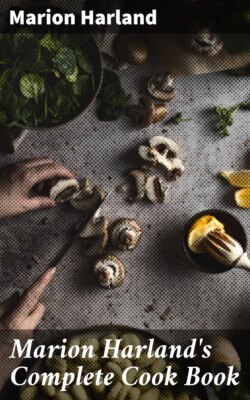Читать книгу Marion Harland's Complete Cook Book - Marion Harland - Страница 4
На сайте Литреса книга снята с продажи.
MARKETING
ОглавлениеTable of Contents
Mutton and BEEF may be called the Marketer’s Perennials. They are in season all the year round.
In buying mutton see that the fat is clear, very firm and white; the flesh close of grain, and ruddy. Buy your meat fresh, even if you mean to hang it in the cellar for a week—or longer in cold weather. “Begin fair!”
The best cuts of mutton are loin, saddle and leg. French chops are cut from the rib, the fat taken off and several inches of the bone cleaned from meat. They are nice to look at, good to eat—and expensive. You can do the trimming at home when you have once seen it done and save the extra cent or two paid for the word “French.” Loin chops are cheaper and usually more tender and better-flavored.
A more economical piece than the leg for the housewife who does her own marketing is the fore-quarter. You can bone and stuff part of it for a roast; the chops are almost as good as those cut from the loin, and the bones, when removed, make good stock for broth. The meat is really more juicy and sweet than that of the leg, and the cost from two to three cents a pound less.
Lamb is in season from May to November. What is sold under that name in winter is undersized mutton, and usually tough and dry.
Beef—the Englishman’s main-stay—is quite as important in the American kitchen. Seek, in purchasing, for rosy, red meat, “shot” with cream-colored suet, dry and mealy, and a good outer coat of fat. Press the meat hard with the tip of your thumb. If it be flabby, and, after yielding to pressure, retains the dent, let it alone.
The rib roast is a choice cut. It is more comely when the bones are removed, the meat rolled and bound into a round. In which case insist upon having the trimmings sent home. You pay for them, and, when you order soup-meat, for that as well. Have the bones cracked, buy one pound of coarse lean beef for perhaps ten cents, and you have foundation for a good gravy soup, or stock enough for several hashes and stews.
The round costs about two-thirds as much as a rib-roast and half as much as a sirloin, and serves admirably for à la mode beef, or a pot-roast.
The sirloin steak is far more economical than a porterhouse. Remove the bone before cooking. This cut often contains really more of the coveted tenderloin than the porterhouse, and the rest of the steak is more tender, as a rule, than the dearer cut. Have the steak cut at least an inch thick.
Summer FRESH PORK is less desirable than winter lamb. It should be barred from the market after the first of May, and not allowed there before December first, if then. The lean should be pink, the fat pure white and solid, the skin like white, translucent parchment. That it is cheap and “goes far” recommends it to many people.
The chine, the spare-ibiss and loin are the best cuts for roasting. Pork chops are popular, and pork tenderloins much affected, even by epicures. Children and invalids should never touch unsalted pork at its best estate.
Veal comes into market earlier than genuine spring lamb, and is seasonable all the summer through. Be sure it is not that most objectionable variety of what is rated by dieticians as a decidedly objectionable meat—known in slang usage as “bob-veal.” No calf should be slaughtered until at least six weeks old. The meat should be a clear, pale red, the fat very white, the texture firm. Veal may be innutritious, but the knuckle and, indeed, all the bony parts are invaluable for soups, containing much gelatinous matter. The breast, the fillet and loin are the most popular roasting pieces. Veal chops are really better eating and cheaper than the cutlet, and should be better known to the frugal housewife.
A calf’s head, scraped free of hair and well-cleaned, may be bought in country markets for fifty cents, and can be made into a dainty dish fit for John and John’s unexpected friend.
Sweetbreads are an acknowledged delicacy, and liver, properly cooked, will be approved by all.
By the way, lamb’s liver costs less than calf’s liver, and is more toothsome.
In choosing POULTRY, slip your bare forefinger under the wing where it joins the body and press hard with the nail. If the skin breaks easily, the fowl is probably young. Then try the tip of the breast-bone. If the cartilage gives readily and springs back slowly, the signs are still favorable. Next, look for hairs on the body and hard horny scales on the legs; for scrawny necks and a livid hue in the flesh—all unfavorable indications. Tough fowls should be cheaper far than tender. If your market-man calls them frankly “fowls,” commend his honesty, and if you contemplate a fricassee or chicken pie, reward his integrity by a purchase. Chickens may be “fowls,” yet good,—that is, nourishing and amenable to judicious “tendering.”
A veteran housewife, with a reputation to support, tells me she has but one method of securing really excellent meats for her table: “When a market-man sells me tough flesh, or superannuated poultry, or ancient fish, I give him warning. At the second offense, I transfer my custom to another dealer. The rule works well!”
It is especially useful when one would be certain of getting FRESH FISH. Now that fish and oysters are bedded in ice until the wiliest connoisseur may be mistaken in their age, it behooves the housemother to know, first of all, that she is dealing with a man with a conscience as free from reproach as she would have her halibut, salmon and oysters.
